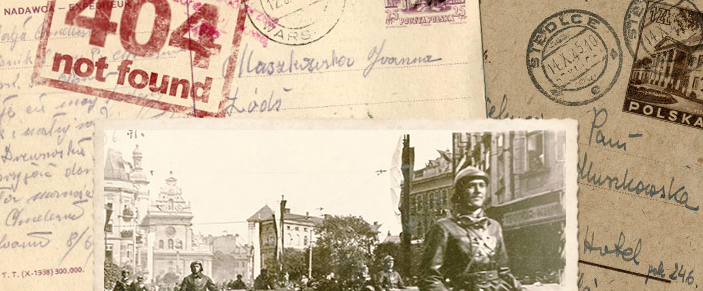
Interview with Paweł Machcewicz, 31 March 2017
WRIGHT You invited representatives of the Law and Justice party — Prawo i Sprawiedliwość (PiS), referred to as simply, Law & Justice — to the Museum of the Second World War in Gdanskopening (on 23rd March 2017), they did not come. How did you feel about that?
MACHCEWICZ Not very well, of course. The Minister of Culture, Piotr Gliński, should be here at the opening. This is the biggest historical museum in Poland. This government and this minister keep saying they care so much about Polish history, and he didn’t come. I can also comment on the way which I learned that he would not come. He did not respond [to] my letter, I didn’t even get any response. I read in his interview with the Polish Press Agency the day before the opening that he was not going to come. Very impolite, I would say.
WRIGHT Have you spoken to Gliński in the past? Is there a personal relationship?
MACHCEWICZ I have spoken to him, yes. Several times, face-to-face, but only once he invited me to his office in Warsaw, just two days after this announcement was made in April (2016) that our museum would be liquidated. There was such a public storm, a wave of indignation, over the weekend, that he invited me for a talk, and it was polite. But it didn’t change anything. And then I talked to him but it was rather a sort of public confrontation. Twice, we were both invited to the parliament, once for the session of the Committee of Culture in the lower chamber, the Sejm—the session was devoted to our museum. The second time, it was the Culture Committee of the Senate, the higher chamber. The second meeting lasted for four hours, but it was a confrontation, you couldn’t call it a discussion.
This is not only Trump, not only Brexit, but also Mr Oban in Hungary, the overt inspiration for our Law and Justice party.
WRIGHT Was it like an argument?
MACHCEWICZ No. He accused us, me and the museum, of things which are not real, like we’re devoting not enough attention to the Polish history and more on international history. Also he accused me of some irregularities in the construction works, he accused me that it lasted longer than it was planned [at] first. He also accused me that I have been staging for months an anti-government campaign, a campaign to discredit this government and himself, and that I want to become the new Minister of Culture, once his government collapses. So it was a little bit ridiculous.
WRIGHT Is this (position) representative of the Law and Justice party generally?
MACHCEWICZ No, this is quite cautious and evolving… I can only say that in the case of Mr Gliński, he’s rather a new man in this Law and Justice party. 10 years ago, he was a liberal scholar, he was a sociologist, a professor of sociology, leading a non-governmental civic organisation, something that would be very far from this mindset of Law and Justice party. In my opinion, he’s a sort of neophyte, trying to convince [party chairman] Jarosław Kaczyński that he’s a hard fighter, that he can also destroy and use innocent people if necessary… for the sake of the party. In my opinion, he’s doing that, he’s using such accusations in order to prove that he’s one of them, in a way.
WRIGHT It seems to be part of the rise of nationalism, Brexit and Trump, would you agree? And this is very relevant, because the exhibition starts with the rise of nationalisms [in the 1930s].

[o]
MACHCEWICZ Yes, in a way you are right. This is not only Trump, not only Brexit, but also [prime minister] Mr Oban in Hungary, which was the overt inspiration for our Law and Justice party. Gliński said many times before he took over power, that Poland should somehow follow the Hungarian example. But also le Pen [in France], a whole wave of such populist nationalist movements. In a way in Poland, it is more difficult to explain why it happened so abruptly, because most people in Poland believed that we are modernising our country, our economy, our society. Poland did not suffer the recession in the last economic crisis. On paper, apparently, everything looked wonderful—economic growth, the decreasing rate of unemployment. But there was some discomfort below the surface. People got frustrated that salaries were low, and also to overcome this financial crisis, our government loosened the labour market, so very many people, especially young people, worked on a flexible, unsafe basis. My son worked in that way, and he was unhappy…
This populist movement in Poland somehow exploited the real discontent… Simply, some growing frustration which was not, perhaps, which was not seen by those people who [were] successful, well-to-do, and so on. This government is nationalistic but has real support in the countryside.
By the way, the countryside benefitted so much from European funds, but still the countryside supports this party. Perhaps because the Catholic church has [a] very strong position… Well, this is a very general picture.
This war was different from other wars because it mostly affected civilians.
WRIGHT Was [EU Commission President, former prime minister and instigator of the Museum] Donald Tusk also invited to the opening?
MACHCEWICZ No, because this would be against the diplomatic protocol. He’s a European statesman, he can be invited by the prime minister [or] the president of Poland. As director, I couldn’t do it.
WRIGHT Perhaps it would have been seen as confrontational.
MACHCEWICZ I was not going to do it. I organised way the opening without politicians. The only one I invited was the minister of culture, because he’s my supervisor in a way, and I did not invite any other politicians. It was very unofficial—veterans, and those who donated objects or articles to the museum. It was very touching in a way—the first person who entered the exhibition was Joanna Penson who is now 95 years old, and who was during the war a member of the Home Army [the Union of Armed Struggle]. She was arrested in 1941 and she spent four years in Ravensbrück concentration camp. I opened this museum in the company of people who really deserved to be there.
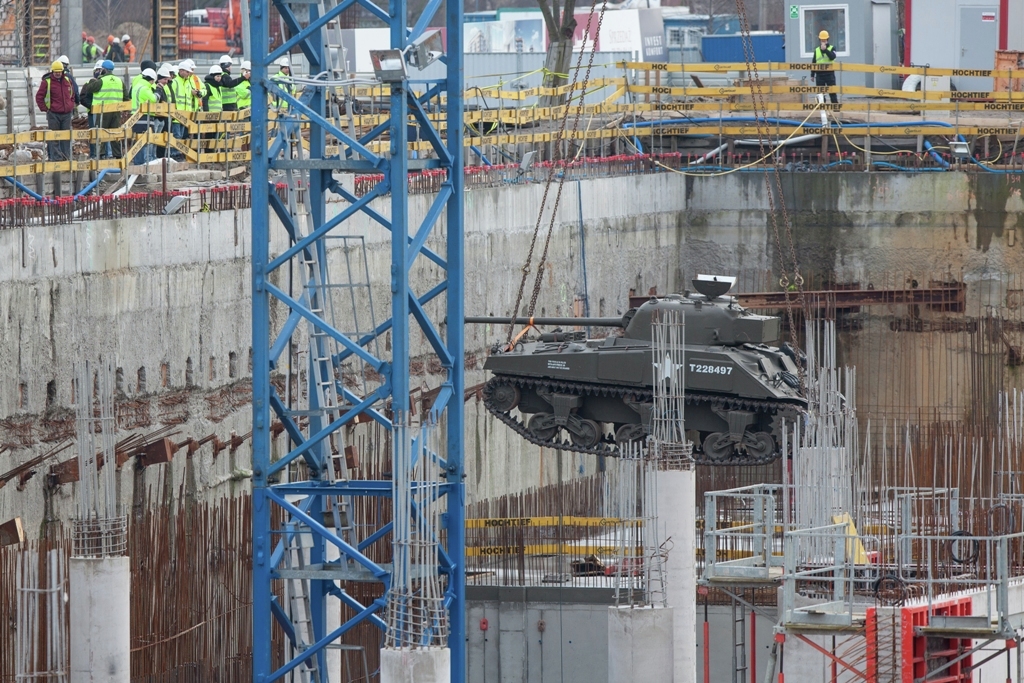
WRIGHT Museums now are becoming entertainment, and have to compete for time and attention with the internet. Do you recognise that problem, and how does this museum respond to that?
MACHCEWICZ In a way we have to face all these challenges, but creating this exhibition, we’re trying to find our own way, and somehow confront the fashion which somehow was created in Poland that a good museum, a modern museum would mean a museum with lots of multimedia. This was the understanding after the opening [in 2004] and due to the great success of the Warsaw Rising Museum [about the Warsaw Uprising, 1944]. People got very excited about that. Of course, we have lots of multimedia—250 installation screens, a lot. But we deliberately focused on finding and integrating into the exhibition artefacts. We have around 2,000 artefacts in the permanent exhibition. For example, just to make a comparison for you, this newly opened [POLIN] Museum of Jewish History in Warsaw is almost purely [a] multimedia museum. They have only 150 original objects. The people who created this museum admit that is a shame, but this Jewish Museum is a child of the 90s. The project was shaped mainly in the 90s and it was the era of the greatest excitement about multimedia.
We try somehow to go beyond this horizon and we are very proud of collecting some first-class original objects. Many of them were donated and out of these 2,000 objects, more or less half are gifts or deposits. I would emphasise that this was a sort of a grass-roots movement which formed itself around the museum, of people who donated objects, supported us last year… Many people who donated family objects said that if our museum was liquidated, they would withdraw these objects. It was a very touching example and I would say an encouraging example of people at large who cared about history. they are also [the] creators of this museum; [it’s] not only the historians and curators.
WRIGHT The architecture by [Gdynia-based architects] Kwadrat is very dramatic, very contemporary. Where you on Daniel Libeskind’s [architectural competition] jury [which selected the design]?

MACHCEWICZ No, I was not on the jury. The choice was made by architects and urban development experts. We got more or less 130 entries for this competition. Almost everyone was excited about this particular entry, so there was not much hesitation.
WRIGHT Are you happy with it?
MACHCEWICZ This is very impressive, very original. This is a benchmark for Gdansk, I would say. My only concern, even at the very beginning, was [for] the construction works to not exceed the budget. Usually, with such original, extravagant architecture, the costs go up, and indeed we exceeded the budget. This was due to the very sophisticated and challenging architecture. The most expensive part was digging 14m below the level of ground. Now, looking at this building, I think this is very worthwhile. Many visitors say the architecture fits very well into the exhibition… It should be understood together with the architecture, the design of our exhibition, and our narrative. But actually it cost more and took more time to build, this is the price you pay for this world-class architecture.
WRIGHT It seems that in the last 20 years, museums have to stand out, they can’t look like a nineteenth-century building . . .
MACHCEWICZ . . . or an IKEA building! It’s worthwhile, although it was a very painful and difficult process to get it all completed. Perhaps with a more banal building, we would have done it one year earlier and it wouldn’t have had all these problems with this new government.
WRIGHT Was the intention to be a catalyst for local development?
MACHCEWICZ It was not the number one reason, but once we were donated this plot by the Mayor of Gdansk, he understood it was a great opportunity to revitalise this part of the city. You now that it was destroyed in 1945 but for many centuries it was a very animated, very vivid part of Gdansk. It had a symbolic meaning to rebuild this part of the city. I understood straight away that this was a great chance for the city, so close to the heart of the Old Town, but at the same time it was a run-down area with just a bus stop and concrete surface. When we removed this surface, we saw the outlines of streets and sidewalks, it was really moving to see the traces of a city which disappeared here.
WRIGHT (returning to the politics of the museum): Is it basically that the Law and Justice party just want to talk about Poland, and the museum addresses the whole war?
MACHCEWICZ Basically yes. They wanted mostly a Polish history museum, which to me seems really absurd because you cannot tell the story of the Second World War only.
WRIGHT …in isolation…
MACHCEWICZ Poland is not isolated. It had enemies, but also allies like Great Britain and the United States. The most important accusation was that we somehow we marginalised Poland. Polish uniqueness is not seen, not underlined enough. They formulated such accusations even before the exhibition was created. It was a sort of ritual accusation.
The second accusation that they kept repeating was that we focus on the fate of civilians and that it should be mostly military history. I find this a little bizarre because this war was different from any other wars because it mostly affected civilians. In the Polish case, the vast majority of people who died were civilians. We owe them recognition.
WRIGHT Has the Catholic church said anything about this cultural dispute between the party and the musuem?
MACHCEWICZ As far as I know, no bishop has ever addressed this issue. The Catholic press is also polarised. There are right-wing newspapers very close to the Catholic church, and they condemn our exhibition. There is a liberal [publication], Więź—they published an interview with me and an editorial with great praise for the museum.
[Editor's note: Więź, meaning link or bond, was founded by Tadeusz Mazowieck, later Poland’s first post-communist prime minister.]
WRIGHT What change do you want to make in the minds of young people who visit the museum?
MACHCEWICZ They are the first generation who may not have any family recollection of the war, only their grandparents can remember. The first task is to convey some basic knowledge, because schools are not fulfilling this task in a sufficient way. Also what we’d like to achieve on a deeper level is to get young people emotionally involved, to understand what war is, what violence is, what suffering is, and what challenges [and] dilemmas ordinary people like them had to face 70 or 80 years ago. We want to effect their values.
When you leave the exhibition, the last scene you will see will be a film showing developments after the war, and the last images are Syria and Ukraine. What you see in this museum is not a closed chapter. The violence is around us, the propensity towards violence could be inside us. Remember that it can be repeated and your task is to somehow avoid such [a] nightmare. But if you happen to be facing this, you can remember about those people whose stories you saw at this exhibition.
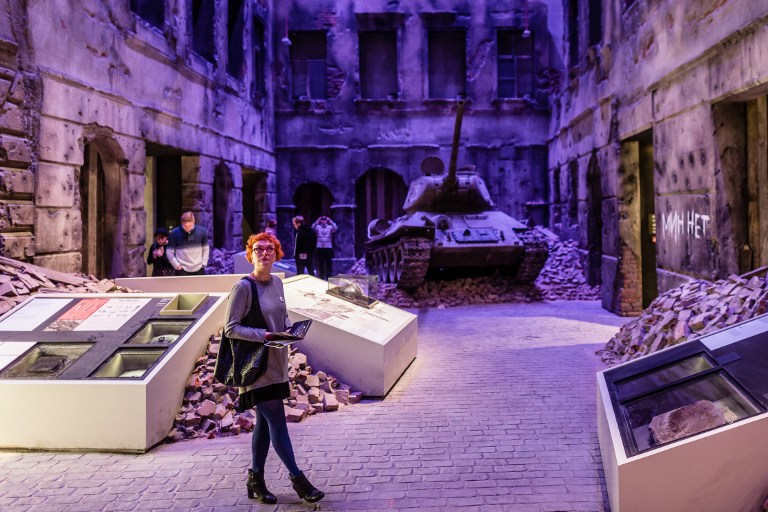
WRIGHT What is the situation with the funding of the museum?
MACHCEWICZ It has already been cut. I had to suspend all publications, all research, all eduction activities. All the money is spent on running this building. I have to hire technical staff. Even with this drastic cuts which I have implemented, we have money for only a few months. Our accountants have calculated that if we don’t have additional funds from the government, or sufficient income from the tickets, you have to start firing people in September. If you want to have money from tickets, you must have the exhibition open, so it’s a catch-22.
But I think the scenario will be different. The government will remove me and install a new director who will get a lot of money from the government. It’s not a question of austerity, the issue is that this museum has been created by us, me and my collaborators.
WRIGHT What would you do if forced from the museum?
MACHCEWICZ I am a professor of history at the Polish Academy of Science, so I’d go back to my academic job. Creating the museum was a very hard job, but I don’t necessarily have to run it. I have my contract valid until the end of 2019. The government by breaking this contract would be violating the law.
The government is trying formally to liquidate our museum. I fight the complaint in the court. The court suspended the merger [with the Museum of Westerplatte and the War of 1939]. On 5th of April, there will be the ruling of the Supreme Court. If it it allows the merger of the museums, I will be gone. If the Supreme Court confirms the suspension of the merger, I think the government will fire me because they never forget that I opened this museum against the minister of culture.
WRIGHT We live in strange times.
MACHCEWICZ The government [that] says it cares so much about Polish history somehow wants to marginalise the biggest history museum which has been opened in Poland. It’s a bit paradoxical. ≈©
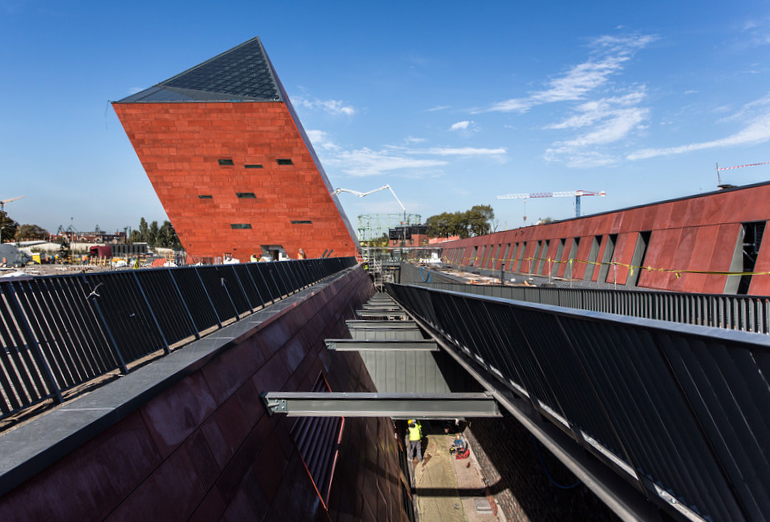
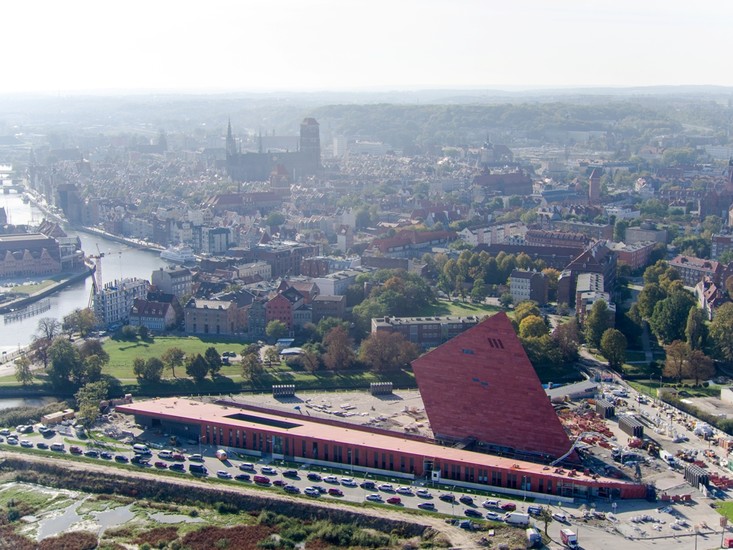
"It had a symbolic meaning to rebuild this part of the city." [o]
FOLLOW-UPS
Dr Piotr M. Majewski was Deputy Director of the museum and dismissed with Professor Machcewicz. He spoke with Herbert Wright in mid-April, who began by asking him about new director Karol Nawrocki.
PIOTOR MAJEWSKI I met him once during a conference. He’s a devoted fan of the Gdansk football team, Lechia Gdańsk, [which has] a political identification with Law and Justice.
HERBERT WRIGHT Nawrocki is a fellow historian—do you think he is impartial?
MAJEWSKI No one is completely impartial, but it’s rather a question of how it influences the research or agenda. Nawrocki said at the beginning of our meeting that the exhibition represents a liberal sensitivity and he would seek to “balance” it. [First] he would evaluate the content. We openly asked his intentions.
WRIGHT What are you doing now?
MAJEWSKI We have decided to assert our intellectual rights. From the beginning, it bore our trademark. We are consulting lawyers, we have contacted a lawyer whose field is intellectual property.
WRIGHT What about those who have donated items to the Museum?
MAJEWSKI They don’t have intellectual rights, but they are free to withdraw objects which are loaned. They have already warned [they may]. We announced an appeal to the donors not to [until legal advice is given]. We don’t want to be seen as [acting in] revenge.
[The advice should come in a matter of weeks.]
WRIGHT How have other institutions internationally reacted?
MAJEWSKI One year ago when the Ministry of Culture announced plans, many institutions around the world signed a protest to the minister [including] the Holocaust Museum in Washington. These voices are important. We think this campaign of support helped to shift [the situation, enabling the Museum to open]. We gained one more year. There is an unpleasant feeling of having built something and it is stolen.
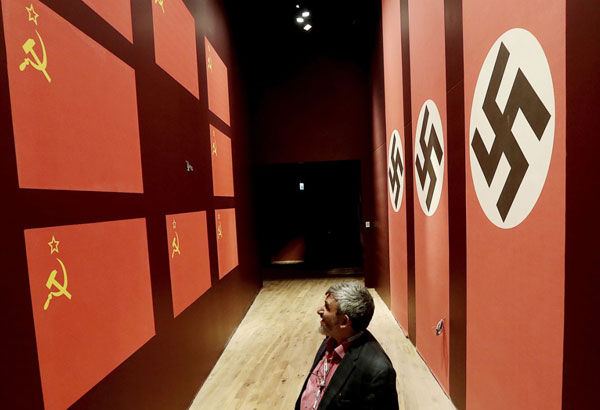
New Director Karol Mawrocki replied via email on 24th April 2017
WRIGHT Do you plan to change the permanent exhibition of the Museum of the Second World War, and if you do, what changes would you make?
KAROL NAWROCKI Of course I retain such right as the director responsible at the moment for the shape of the institution. Many changes are in progress—even being reported by employees themselves. Every day brings something new, scientific research is ahead, the desire to convey the memorabilia was announced today (Sunday 23rd) by Anna Maria Anders, the daughter of the legendary Polish general. Other donors want to donate their exhibits either. It would be wrong not to use such opportunities and instead respond—no, nothing can be changed. There is no museum in the world in which nothing would change … In addition, there is no finite work in science; I am listening to the reflections of historians of varying sensitivity and if I consider that something should change after the opinion of experts or in the result of new research then I will do change it. It’s natural.
WRIGHT Are there plans for a museum building at Westerplatte, or will it remain an outdoor exhibition as is it now?
NAWROCKI The Westerplatte peninsula has a very difficult land ownership problem—managed by 11 institutions. Segregation of space for permanent exposure, ranking of ownership structure and start of investment will bring both the Museum of WW II, Poland and the whole World another special place of historical education, which will tell about the beginning of the world conflict and the heroic attitude of Poles in the face of German Nazism.

HERBERT WRIGHT is a London-based author and journalist specializing in architecture and art. He studied physics and astrophysics at the University of London. He is currently a contributing editor of Blueprint magazine, and contributor-at-large to Design Curial. www.herbertwright.co.uk


Add new comment